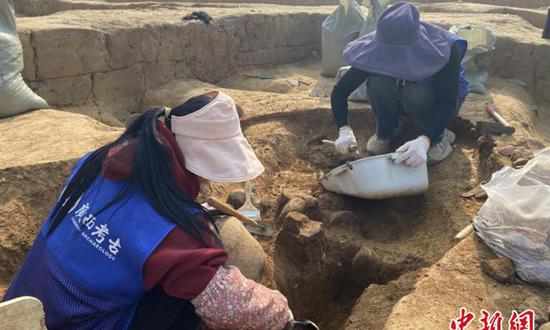Earliest urban settlement unearthed in Lingnan reframes history of city construction

Staff members work on excavation at the Niuluchong site in Gucheng village, Guilin, South China's Guangxi Zhuang Autonomous Region. (Photo/China News Service)
The earliest city site in Lingnan was discovered, pushing back the history of urban construction in the region from the late Warring States Period (475BC-221BC) to the Shang Dynasty (1600BC-1046BC), said He Anyi, a team leader from the Guangxi Institute of Cultural Relics Protection and Archaeology, on Tuesday.
"Since September 2024, our archaeological team has carried out rescue excavations at the Niuluchong site, where we discovered the earliest city site in the Lingnan region," said He in an interview with Chinanews.com. Lingnan region covers south of the Nanling Mountains, a west-east group of mountains in southern China.
The excavation provides an important archaeological evidence for the evolution of early civilizations in Lingnan and South China and the process of unification that led to diverse groups to integrate to form the Chinese civilization.
The Niuluchong site is located in Gucheng village, Guilin, Guangxi Zhuang Autonomous Region at the intersection of the Chajiang River and Shijiang River, in a typical intermountain basin surrounded by hills and karst mountains. The site extends about 160 meters north to south and 140 meters east to west, covering a total area of 23,100 square meters.
Low city walls were unearthed on the north, west and south edges, while trenches were found outside the west and south ancient city walls.
Judging from the map, the ruins were built along the river. In ancient times the locals chose to build a city and settle in the area due to the characteristics of the terrain and its advantageous position, which was conducive to domestic defense, as well as the management and control of waterways, He said.
The team conducted archaeological exploration at the Niuluchong site in April 2024 using a trenching method, and confirmed for the first time that the site belonged to the Late Neolithic to the Shang Dynasty, preliminarily determining that the city wall was an early Lingnan city site.
Starting from September 1, 2024, a group of archaeological remains from the late Neolithic Age to the Shang Dynasty were unearthed. Ash pits, pillar holes, city walls, and trenches were discovered among the ruins. The cultural relics include pottery, stone tools, and carbonized rice.
The remains of ash pits, pillar holes and unearthed cultural relics belong to cultural relics from the late Neolithic Age to the Shang Dynasty, He explained. Through the study of the unearthed city walls and trenches, the team determined that the site is the earliest urban settlement discovered so far in Lingnan.
"Most of the stone tools excavated this time include both forged and ground stone tools, such as arrowheads and stone rings. According to common sense, the late Neolithic Age should be dominated by ground stone tools. However, hammered stone tools reflect the cultural characteristics of the Lingnan region," said He.
